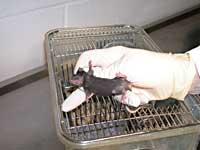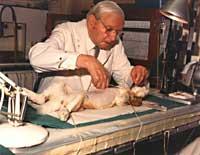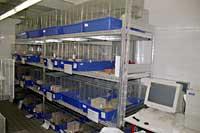Towards entrepreneurs for animals

Demonstrations for animal rights are usually held peacefully. However, it seems that in some cases entrepreneurs also use threats and violence, and in Britain a bill against those attitudes is being discussed. In the event of the proposed legislation, entrepreneurs who commit abuses will be punished with penalties of up to five years in prison.
It is not surprising that this bill has been exposed in Britain, where the attitude in favor of animal rights is very evident in society, and sometimes there are strong acts of protest to prevent the use of animals in research: attacks against laboratories and the threat of some researchers.
As a result, laboratories invest a lot of money in security and these expenses have led to the paralyzation of several projects. This is the case of the largest primates laboratory in Europe to be built in England.
Britain has been a pioneer in defending animal rights, as they were the first to regulate animal work in laboratories under the Animal Cruelty Act in 1876. This law regulated an experimental protocol and established a licensing system that is currently used in many places. In most European countries a license is needed to investigate animals, indicating the experiments to be carried out in the application.
Ethical debate

These experiments cause suffering and death to animals, which necessarily implies an ethical debate. In this sense, the European Parliament adopted the decision to reduce the use of animals by 50% by 2000, but this decision has not been fulfilled. Since the Member States committed to optimizing methods, they have made measurements, and although the number of animals used between 1996 and 1999 decreased, by 2002 it increased again.
A 12-minute animal is used in the European Union, in Japan for two minutes and in the United States for one minute. The United Kingdom is the country that uses the most animals for research in the European Union, followed by France and Germany.
Many have been the advances in the fight against human diseases thanks to experiments with animals. They have been developed using various techniques and animal treatments currently common. This is the case of anesthesia.

In 1885, after investigating infectious diseases with animals, Pasteur made a vaccine against cholera and rabies. This is only the beginning of a long list, since animal research has led to the obtaining of other vaccines such as polo, rubella, tuberculosis, measles, seeds, etc.
On the other hand, animal interventions were of great help in developing organ transplant and cardiac surgery techniques. Antibiotics and treatments for diabetes and cancer also depend heavily on animal testing.
Unexpected results
However, despite the high expectations generated by animal research, sometimes the differences between animals and humans are too large. For many scientists, these differences can be balanced in experiments, but on several occasions it has occurred that a treatment with spectacular results in animals does not have the same influence on humans.
On the other hand, various products and drugs have been tested and marketed in humans after animal testing and, in the long term, problems that did not appear in animals have been detected. It was the case of Taliomide, for example. This drug was killed between 1955 and 1967 to combat the dizziness of pregnancy and caused serious malformations in thousands of children.

The opposite has also occurred and some products that did not affect animals or generate problems are very important for humans. Digoxin, for example, caused serious experimental damage to animals, but it is a basic medicine to treat heart disease.
For all this, many believe that experiments can be reduced and results optimized, since research is repeated in different places due to lack of communication between laboratories and economic competition. At the moment it is not possible to use any animal during the research, but sharing data would mean at least a lower use of animals in the research.
Published in 7K.
Buletina
Bidali zure helbide elektronikoa eta jaso asteroko buletina zure sarrera-ontzian











